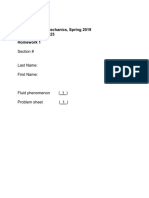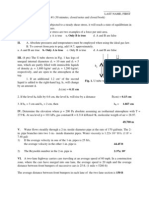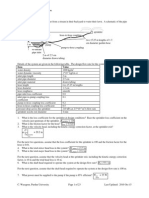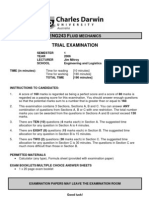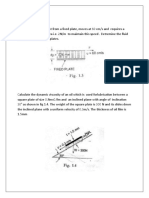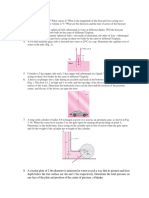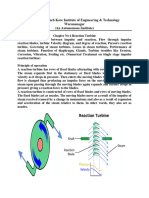Problems Set 1 PDF
Problems Set 1 PDF
Uploaded by
abdghfarCopyright:
Available Formats
Problems Set 1 PDF
Problems Set 1 PDF
Uploaded by
abdghfarOriginal Title
Copyright
Available Formats
Share this document
Did you find this document useful?
Is this content inappropriate?
Copyright:
Available Formats
Problems Set 1 PDF
Problems Set 1 PDF
Uploaded by
abdghfarCopyright:
Available Formats
1.12 ffiu's For each of the Mowing units in Table F.
I (front of
book), present in terms of its primary dimensions: kWh, poise,
slug, cfm, cSt.
2.59 TJJUS A water bug is suspended on the surface of a pond by
surface tension (water does not wet the legs). The bug has six
legs, and each leg is in contact with the water over a length of
5 mm. What is the maximum mass (in grams) of the bug if it is
to avoid sinking?
1.19 T u s If the local atmospheric pressure is 93 kPa, use the
grid method to find the pressure in units of
/a. psia
b. psf
c. bar
/d. atmospheres
e, feet of water
i/f. inches of mercury
PROBLEM 2.59
2.7 What are SG, -y, and p for mercury? State your answers in SI
units and in traditional units.
2.16 ffuJ's Regarding water and seawater:
a. Which is more dense, seawater or freshwater?
3.4 O T e local atmospheric pressure is 99.0 kPa. A gage on
i ^ oxygen tank reads a pressure of 300 kPa gage. What is the
pressure in the tank in kPa abs?
b. Find (SI units) the density of seawater (10C, 3.3%
salinity).
3 19 RegardingthehydraulicjackinProblem3.18 whichideas
c. Find the same in traditional units.
were used to analyze the jack? (select all that apply)
d. What pressure is specified for the values in (b) and (c)?
a.
2.29 p
SAE 10W-30 oil with viscosity 1 X 10~4 Ibf s/ft2 is used
as a lubricant between two parts of a machine that slide past one
another with a velocity difference of 6 ft/s. What spacing, in inches,
is required if you don't want a shear stress of more than 2 Ibf/ft2?
pressure = (force)(area)
ft, pressure increases linearly with depth in a hydrostatic fluid
c. the pressure at the very bottom of the 4-cm chamber is larger
than the pressure at the very bottom of the 10-cm chamber
! d. when a body is stationary the sum of forces on the object
is zero
e. when a body is stationary, the sum of moments on the
object is zero
2.44 Common Newtonian fluids are
f. pressure = (weight/volume) (change in elevation)
a. toothpaste, catsup, and paint
b. water, oil, and mercury
c. all of the above
3.16 TLiJS For the closed tank with Bourdon-tube gages tapped
into it, what is the specific gravity of the oil and the pressure
reading on gage C?
L
2.54 Find the kinematic and dynamic viscosities of air and water
at a temperature of 40C (104F) and an absolute pressure of
170kPa(25psia).
PROBLEM 3.16
3.53 Wife Determine the gage pressure at the center of pipe A in
pounds per square inch and in kilopascals.
:>./s me gate snown is rectangaiar ana nas dimensions t> m by 4 m.
What is the reaction at point A? Neglect the weight of the gate.
Hinge
Atmospheric
pressure
PROBLEM 3.75
*" Mercury
3.88 For the curved surface AB:
PROBLEM 3.53
3.54 A device for measuring the specific weight of a liquid
consists of a U-tube manometer as shown. The manometer tube
has an internal diameter of 0.5 cm and originally has water in it.
Exactly 2 cm3 of unknown liquid is then poured into one leg of
the manometer, and a displacement of 5 cm is measured between
the surfaces as shown. What is the specific weight of the
unknown liquid?
a. Determine the magnitude, direction, and line of action of
the vertical component of hydrostatic force acting on the
surface. Here = 1 m.
b. Determine the magnitude, direction, and line of action of
the horizontal component of hydrostatic force acting on
the surface.
c. Determine the resultant hydrostatic force acting on the
surface.
Unknown liquid
3.107 *pTus Determine the minimum volume of concrete
(y = 23.6 kN/m3) needed to keep the gate (1 m wide) in a closed
position, with = 2 m. Note the hinge at the bottom of the gate.
0.5cm
Water
PROBLEM 3.54
3.69 TOJS For gate A, choose the statements that are valid:
(a) The hydrostatic force acting on the gate increases as H
increases, (b) The distance between the CP on the gate and the
centroid of the gate decreases as H increases, (c) The distance
between the CP on the gate and the centroid of the gate remains
constant as H increases, (d) The torque applied to the shaft to
prevent the gate from turning must be increased as H increases,
(e) The torque applied to the shaft to prevent the gate from
turning remains constant as H increases.
PROBLEM 3.107
3.114 rpTus The hydrometer shown sinks 5.3 cm (z - 5.3 cm) in
water (15C). The bulb displaces 1.0 cm3, and the stem area is 0.1 cm2.
Find the weight of the hydrometer.
PROBLEMS 3.68,3.69
3,67 pjOlS What is the force acting on the gate of an irrigation
ditch if the ditch and gate are 4 ft wide, 4 ft deep, and the ditch is
competely full of water? There is no water on the other side of
the gate. The weather has been hot for weeks, so the water is 70E
PROBLEMS 3.113,3.114
4.49 TLUS A water jet issues vertically from a nozzle, as shown.
The water velocity as it exits the nozzle is 18 m/s. Calculate how
high h the jet will rise. (Hint: Apply the Bernoulli equation along
the centerline.)
The velocity at section A-A is 15 ft/s, and the vertical
7 at the same section is 4 ft. If the width of the channel is
what is the discharge in cubic feet per second?
-.A horizontal water jet at 70F impinges on a verticaljndicular plate. The discharge is 2 cfs. If the external force
to hold the plate in place is 200 Ibf, what is the velocity
;;water?
'
PROBLEM 4.49
4.55 TLUS A glass tube is inserted into a flowing stream of water
with one opening directed upstream and the other end vertical. If
the water velocity is 5 m/s, how high will the water rise in the
vertical leg relative to the level of the water surface of the stream?
6.20 A conveyor belt discharges gravel into a barge as shown at
a rate of 50 yd3/min. If the gravel weighs 120 lbf/ft3, what is the
tension in the hawser that secures the barge to the dock?
Conveyor belt
10 ft/s
Gravel
Barge
PROBLEM 6.20
PROBLEM 4.55
4.52 HUJS Kerosene at 20C flows through a contraction section
as shown. A pressure gage connected between the upstream pipe
and throat section shows a pressure difference of 20 kPa. The
gasoline velocity in the throat section is 8 m/s. What is the
velocity (m/s) in the upstream pipe?
6.26 Ink A water jet with a speed of 30 ft/s and a mass flow rate
of 35 Ibm/s is turned 30 by a fixed vane. Find the force of the
water jet on the vane. Neglect gravity.
20 ft/s
Kerosene at 20 C
PROBLEM 4.52
5.9 A pipe with a 2 m diameter carries water having a velocity of
4 m/s. What is the discharge in cubic meters per second and in
cubic feet per second?
30
PROBLEM 6.26
6.59 JLks The pipe shown has a 180 vertical bend in it. The
diameter D is 1 ft, and the pressure at the center of the upper
pipe is 15 psig. If the flow in the bend is 20 cfs, what external
force will be required to hold the bend in place against the
action of the water? The bend weighs 200 Ibf, and the volume
of the bend is 3 ft3. Assume the Bernoulli equation applies
(p = 62.4 lbm/ft3.)
6.64 This 30 vertical bend in a pipe with a 2 ft diameter carries
water (p = 62.4 lbm/ft3) at a rate of 31.4 cfs. If the pressure pi is
10 psi at the lower end of the bend, where the elevation is 100 ft,
andp2 is 8.5 psi at the upper end, where the elevation is 103 ft,
what will be the vertical component of force that must be exerted
by the "anchor" on the bend to hold it in position? The bend
itself weighs 300 Ib, and the length L is 4 ft.
7.25 Determine the discharge in the pipe and the pressure at
point B. Neglect head losses. Assume a = 1.0 at all locations.
1.5m
40 cm diameter
Expansion joints to
eliminate force transfer
between pipe and
bend
20 cm-diameter nozzle
PROBLEM 7.25
PROBLEM 6.64
7.29 TLUS For this diagram of an industrial pressure washer 1
system, x = I ft,)' = 3 ft, z = 10 ft, Q = 3.5 ftVs, and the hose
diameter is 4 in. Assuming a head loss of 1 ft is derived over the 1
distance from point 2 to the jet, what is the pressure at point 2 if tf
jet from the nozzle is 1-in in diameter? Assume ex = 1.0
Fill in the blank. Show your work.
a. 1000 1 = _
Cal.
_ ft-lbf = energy to lift a 10 N weight through an
elevation difference of 125 m.
12000 Btu = _
32ft-lbf/s = _
kWh.
.hp.
PROBLEMS 7.28,7.29
fte. [] = [energy] = .
7.9 An engineer is considering the development of a small wi^
turbine (D = 1.25 m) for home applications. The design wind
speed is 15 mph at T = 10C andp = 0.9 bar. The efficiency Of I
the turbine is TJ = 20%, meaning that 20% of the kinetic energy
in the wind can be extracted. Estimate the power in watts that
can be produced by the turbine. Hint: In a time interval At, the
amount of mass that flows through the rotor is Am == wA
the corresponding amount of kinetic energy in this flow is
(AmV2/2).
7.52 TLUS Neglecting head losses, determine what power the
pump must deliver to produce the flow as shown. Here the
elevations at points A, B, C, and D are 40 m, 65 m, 35 m, and
30 m, respectively. The nozzle area is 25 cm2.
Air
PROBLEMS 7.51,7.52
PROBLEM 7.9
7.56 frTu$A small-scale hydraulic power system is shown. Tft
elevation difference between the reservoir water surface and ;
the pond water surface downstream of the reservoir, H, is 24 m
The velocity of the water exhausting into the pond is 7 m/s, an'|
the discharge through the system is 4 m3/s. The head loss due t
friction in the penstock (inlet pipe to turbine, under very high i
pressure) is negligible. Find the power produced by the turbine
in kilowatts.
..j
PROBLEM 7.56
7.55 T G O If the discharge is 500 cfs, what power output may
be expected from the turbine? Assume that the turbine
efficiency is 90% and that the overall head loss is 1.5 V2/2g,
Turbine
PROBLEM 7.55
7 59 (Slfe The PumP shown draws water through an 8 in.
suction pipe and discharges it through a 6 in. pipe in which the
velocity is 12 ft/s. The 6 in. pipe discharges horizontally into air
at C. To what height h above the water surface at A can the water
be raised if 17 hp is used by the pump? The pump operates at
60% efficiency and that the head loss in the pipe between A and
qual to 2 Vc/2g. Assume a = 1.0 throughout.
You might also like
- Hydraulics ReviewerDocument146 pagesHydraulics Reviewermalditaako66% (47)
- Production of Acetic Acid by Methanol CarbonylationDocument68 pagesProduction of Acetic Acid by Methanol CarbonylationNoman Aslam100% (5)
- Elliot Turbine ManualDocument49 pagesElliot Turbine ManualScribdTranslations100% (2)
- Homeworks 1-10 PDFDocument95 pagesHomeworks 1-10 PDFWendy LinNo ratings yet
- Astm D 3182Document6 pagesAstm D 3182quimico0850% (2)
- Calısma SorularıDocument23 pagesCalısma SorularıMiguelaTayNo ratings yet
- Assignment 4Document10 pagesAssignment 4mahmoud EissaNo ratings yet
- GE Energy: Gas Turbine Site Performance Test and Correction ProcedureDocument42 pagesGE Energy: Gas Turbine Site Performance Test and Correction ProcedureRafael Curiel MedinaNo ratings yet
- Past ExamDocument16 pagesPast ExamAlex ChungNo ratings yet
- Fluid Mechanics July 2013Document0 pagesFluid Mechanics July 2013Prasad C MNo ratings yet
- AnnieDocument6 pagesAnnieAnnie Glorina LumauigNo ratings yet
- Assignment Sheet No 2 - 2016Document8 pagesAssignment Sheet No 2 - 2016Muhammad Haseeb JavedNo ratings yet
- FLuid Mechs ExercisesDocument8 pagesFLuid Mechs ExercisesMark Andrew TabucanonNo ratings yet
- Assignment 2 20232024-1Document8 pagesAssignment 2 20232024-1mhaikalirsyad03No ratings yet
- HydraulicsDocument24 pagesHydraulicsCharizza Montarin CENo ratings yet
- HYDRODYNAMICSDocument28 pagesHYDRODYNAMICSSysy monmonNo ratings yet
- Group Assignment IDocument5 pagesGroup Assignment Ilelisagetachew90No ratings yet
- PipeFlow PracticeProblemsDocument23 pagesPipeFlow PracticeProblemsFawaz PartoNo ratings yet
- Assignment Topic AlternatifDocument6 pagesAssignment Topic AlternatifGalihmery DamaiantiNo ratings yet
- Prac Prob HGE 2Document8 pagesPrac Prob HGE 2jeannechoiashNo ratings yet
- Suggestions For External Examination - Fluid MechanicsDocument6 pagesSuggestions For External Examination - Fluid MechanicsArghya PaulNo ratings yet
- Day 24 - Fluid Mechanics L Lecture ProblemsDocument3 pagesDay 24 - Fluid Mechanics L Lecture Problemsj4240300No ratings yet
- Assignment 2 - CE2040Document4 pagesAssignment 2 - CE2040Ash0% (1)
- S06-All Examples 2upDocument5 pagesS06-All Examples 2upAvinash MeenaNo ratings yet
- MM204 Assn3 2017Document5 pagesMM204 Assn3 2017jayNo ratings yet
- Basics of Pumps and Hydraulics: Instructor GuideDocument9 pagesBasics of Pumps and Hydraulics: Instructor Guideعمار ياسرNo ratings yet
- Ce6303-Mechanics of FluidsDocument10 pagesCe6303-Mechanics of FluidsDineshNo ratings yet
- Problem A RioDocument9 pagesProblem A RioKoe Chien ThongNo ratings yet
- Tutorial 4 QuestionsDocument2 pagesTutorial 4 QuestionsJiNx AngNo ratings yet
- Fluid Mechanics Exam 2Document8 pagesFluid Mechanics Exam 2Diego FungNo ratings yet
- Fluid MechanicsDocument50 pagesFluid MechanicsLurking RogueNo ratings yet
- Bep April 2004Document5 pagesBep April 2004e5865domingoascotbaguioNo ratings yet
- Question AnwerDocument23 pagesQuestion AnwerOnsoti NyaberaNo ratings yet
- Homework SolutionDocument25 pagesHomework SolutionHirman De Nova0% (1)
- Sheet 7 - Applications To Bernolli Equation (2) - Cavitation and NPSHDocument4 pagesSheet 7 - Applications To Bernolli Equation (2) - Cavitation and NPSHengmanarhanafi1No ratings yet
- Post Assessment 1Document2 pagesPost Assessment 1Light HouseNo ratings yet
- CC 406 - Hydraulics and Hydraulic Machinery Time: Three Hours Maximum: 100 Marks Answer ALL Questions. PART A - (10 X 2 20 Marks)Document7 pagesCC 406 - Hydraulics and Hydraulic Machinery Time: Three Hours Maximum: 100 Marks Answer ALL Questions. PART A - (10 X 2 20 Marks)AlexdorwinaNo ratings yet
- Eng Trial ExamDocument11 pagesEng Trial ExamudinjcNo ratings yet
- Fluid Mechanics (4th Year)Document2 pagesFluid Mechanics (4th Year)Jaypee Calamba100% (1)
- IMPORTANT QUESTIONS For Final (KEC) Fluid Mechanic - Line Academy Part 1Document45 pagesIMPORTANT QUESTIONS For Final (KEC) Fluid Mechanic - Line Academy Part 1आदित्य राज अधिकारीNo ratings yet
- hw3 SolnDocument5 pageshw3 SolnWazy RahmanNo ratings yet
- Physics 14 HWDocument2 pagesPhysics 14 HWMelody KimNo ratings yet
- Ch5 Finite CV AnalysisDocument64 pagesCh5 Finite CV AnalysisAsif SunnyNo ratings yet
- Fluid Sheet For Oct - Students 2017Document7 pagesFluid Sheet For Oct - Students 2017S.A. BeskalesNo ratings yet
- Test 2/ Exam, Fluid Mechanics For W, Vvr120 18 OCTOBER 2011, 14:00-17:00 (Test 2), 14:00-19:00 (Exam)Document8 pagesTest 2/ Exam, Fluid Mechanics For W, Vvr120 18 OCTOBER 2011, 14:00-17:00 (Test 2), 14:00-19:00 (Exam)Prashant KCNo ratings yet
- Thapar University, Patiala Department of Chemical EngineeringDocument2 pagesThapar University, Patiala Department of Chemical EngineeringsahibjotNo ratings yet
- AGUSTIN Problem Set 3Document15 pagesAGUSTIN Problem Set 3John Mark Sanchez100% (1)
- Hydraulics FinalDocument9 pagesHydraulics FinalChristian Dela VegaNo ratings yet
- HydraulicsDocument4 pagesHydraulicsHakdog GieNo ratings yet
- Assignment I SKPU1123 1213 2Document4 pagesAssignment I SKPU1123 1213 2Rajab AliNo ratings yet
- 100 Sloved Problems in Fluid MechanicspDocument16 pages100 Sloved Problems in Fluid Mechanicsp852sx4h7cbNo ratings yet
- Major Probables MEE 290Document5 pagesMajor Probables MEE 290m-772007No ratings yet
- L3 Fluid Mechanics Review QuestionsDocument4 pagesL3 Fluid Mechanics Review QuestionsxymaximumNo ratings yet
- CE372 Midterm BlankDocument7 pagesCE372 Midterm BlankAsad YousafNo ratings yet
- EXERCISEDocument6 pagesEXERCISEJerico Enriquez CacaoNo ratings yet
- Mech280final 2013Document14 pagesMech280final 2013manrabrarNo ratings yet
- Fluid Mechanics Worksheet 2Document8 pagesFluid Mechanics Worksheet 2anon_293092329No ratings yet
- 18bt01036 FFO Lab ManualDocument25 pages18bt01036 FFO Lab ManualSarthak LathiyaNo ratings yet
- Review Chem Eng3 Flow of Fluids PDFDocument4 pagesReview Chem Eng3 Flow of Fluids PDFOwenPonceUmacobNo ratings yet
- Assignment FM 2Document2 pagesAssignment FM 2KrijayNo ratings yet
- The Mechanics of Water-Wheels - A Guide to the Physics at Work in Water-Wheels with a Horizontal AxisFrom EverandThe Mechanics of Water-Wheels - A Guide to the Physics at Work in Water-Wheels with a Horizontal AxisNo ratings yet
- 1000 Solved Problems in Fluid Mechanics (Includes Hydraulic Machines) by K. YaDocument5 pages1000 Solved Problems in Fluid Mechanics (Includes Hydraulic Machines) by K. YaAsad Islam20% (15)
- HWCH 2Document7 pagesHWCH 2abdghfarNo ratings yet
- HWCH 2Document7 pagesHWCH 2abdghfarNo ratings yet
- United Arab Emirates University Faculty of Science - Department of PhysicsDocument1 pageUnited Arab Emirates University Faculty of Science - Department of PhysicsabdghfarNo ratings yet
- Course Manual 2011-2012Document136 pagesCourse Manual 2011-201220091273No ratings yet
- VBR Technical Capabilities OverviewDocument2 pagesVBR Technical Capabilities OverviewAriana GrandeNo ratings yet
- Hydraulics New ProblemsDocument5 pagesHydraulics New ProblemsEugine BalomagaNo ratings yet
- Pipe CNS 01Document37 pagesPipe CNS 01maria katherine pantojaNo ratings yet
- 25mm de Transducer System 105826-01 Rev DDocument74 pages25mm de Transducer System 105826-01 Rev DHamid HannitNo ratings yet
- RE PPT - 3Document23 pagesRE PPT - 320-811 mohd AleemNo ratings yet
- Trebu Technology Group PDFDocument20 pagesTrebu Technology Group PDFAP Advisory BVNo ratings yet
- Cu 31924031260254Document78 pagesCu 31924031260254pradipkbNo ratings yet
- Book 9HA CCPP Operations Training at AEPLDocument174 pagesBook 9HA CCPP Operations Training at AEPLFazalur Rehman Babar100% (5)
- Wind Turbine Design ProcedureDocument4 pagesWind Turbine Design ProcedureEkambaramMuniyandi100% (1)
- Chap 6 Reaction TurbineDocument10 pagesChap 6 Reaction TurbineSourabh SalunkheNo ratings yet
- Pipe LastDocument8 pagesPipe LastRENE JOSHUA PECASONo ratings yet
- Physics Lab ReportDocument9 pagesPhysics Lab Reportapi-350808250No ratings yet
- Micro Hydro Power System AssignmentDocument9 pagesMicro Hydro Power System AssignmentCendolz IssZulNo ratings yet
- Newly Commissioned Celebrity Silhouette Steps Into LimelightDocument12 pagesNewly Commissioned Celebrity Silhouette Steps Into LimelightKamal WanniarachchiNo ratings yet
- Co Ordinated Master Control (CMC) : by V.HariayyappanDocument25 pagesCo Ordinated Master Control (CMC) : by V.HariayyappanRavi Satyapal100% (3)
- Disc and Drum: Tow TypesDocument4 pagesDisc and Drum: Tow TypesAwantika SinghNo ratings yet
- Worksheet 1Document1 pageWorksheet 1sharmashnNo ratings yet
- Losses in Steam TurbineDocument6 pagesLosses in Steam TurbineMohamed Abashar Musmar100% (1)
- COE cv35Document3 pagesCOE cv35Shaquain LongvilleNo ratings yet
- Core Compressor Aerodynamic DesignDocument31 pagesCore Compressor Aerodynamic DesignDavid RowlandsNo ratings yet
- Steam Turbines: Prepared By, M.S.Steve, Assistant Professor, Amal Jyothi College of Engineering, KanjirapallyDocument27 pagesSteam Turbines: Prepared By, M.S.Steve, Assistant Professor, Amal Jyothi College of Engineering, Kanjirapallylouiswang1964No ratings yet
- Astm A788-11Document13 pagesAstm A788-11Jeffry Daud Barrung100% (2)
- Bhel Traning ReportDocument31 pagesBhel Traning Reportdivyank kumarNo ratings yet
- MECHANICAL (AUTOMOBILE) ENGINEERING - 2019-Scheme-S3-Syllabus - Ktustudents - inDocument44 pagesMECHANICAL (AUTOMOBILE) ENGINEERING - 2019-Scheme-S3-Syllabus - Ktustudents - injishnu unniNo ratings yet
- Minilab SpecsDocument5 pagesMinilab SpecsFrancisco DesiderioNo ratings yet



